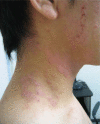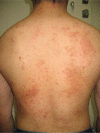A case report of acute dermatitis that developed during an experiment examining the bromination of 3-hexylthiophene
- PMID: 20187972
- PMCID: PMC2842484
- DOI: 10.1186/1745-6673-5-3
A case report of acute dermatitis that developed during an experiment examining the bromination of 3-hexylthiophene
Abstract
Occupational cases with allergic reaction to fragrance substances, which refer to various chemicals providing aroma characteristics, are arising with its recent usage diversification from pharmaceutical, perfume industry to aromatic remedies. However, chemicals responsible for fragrance allergy have hardly been identified because its component is complex and its sensitization is not frequent. This report will present a case of acute allergic dermatitis that is likely induced by 3-hexylthiophene, one of aromatic compounds often contained in fragrance substances. The case, who was a 27-year male researcher engaged in organic chemical synthesis for six years, was exposed to 3-hexylthiophene and its product (2-bromo-3-hexylthiophene) through an experiment in May 2004 and itching, swelling and eczema immediately developed from face to back. This case of sensitization to 3-hexylthiophene suggests that it be a possible allergen for fragrance allergy.
Figures
Similar articles
-
Fragrance allergic contact dermatitis.Dermatitis. 2014 Sep-Oct;25(5):232-45. doi: 10.1097/DER.0000000000000067. Dermatitis. 2014. PMID: 25207685 Review.
-
Fragrance allergy and quality of life - a case-control study.Contact Dermatitis. 2014 Feb;70(2):81-9. doi: 10.1111/cod.12128. Contact Dermatitis. 2014. PMID: 24450824
-
A link between skin and airways regarding sensitivity to fragrance products?Br J Dermatol. 2004 Dec;151(6):1197-203. doi: 10.1111/j.1365-2133.2004.06251.x. Br J Dermatol. 2004. PMID: 15606515
-
[Contact allergy to fragrances].Med Pr. 2006;57(5):431-7. Med Pr. 2006. PMID: 17340985 Polish.
-
Review on perfume and present status of its associated allergens.J Cosmet Dermatol. 2021 Feb;20(2):391-399. doi: 10.1111/jocd.13507. Epub 2020 Jun 16. J Cosmet Dermatol. 2021. PMID: 32445606 Review.
References
-
- Keane FM, Smith HR, White IR, Rycroft RJ. Occupational allergic contact dermatitis in two aromatherapists. Contact Dermatitis. 2000;43:49–51. - PubMed
LinkOut - more resources
Full Text Sources



